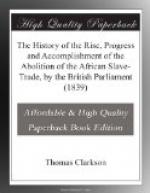After the death of Cardinal Ximenes, the emperor Charles the Fifth, who had come into power, encouraged the Slave Trade. In 1517, he granted a patent to one of his Flemish favourites, containing an exclusive right of importing four thousand Africans into America. But he lived long enough to repent of what he had thus inconsiderately done; for in the year 1542, he made a code of laws for the better protection of the unfortunate Indians in his foreign dominions, and he stopped the progress of African slavery by an order that all slaves in his American islands should he made free. This order was executed by Pedro de la Gasca. Manumission took place as well in Hispaniola as on the Continent; but on the return of Gasca to Spain, and the retirement of Charles into a monastery, slavery was revived.
It is impossible to pass over this instance of the abolition of slavery by Charles, in all his foreign dominions, without some comments. It shows him, first, to have been a friend both to the Indians and the Africans, as a part of the human race; it shows he was ignorant of what he was doing when he gave his sanction to this cruel trade; it shows when legislators give one set of men undue power over another, how quickly they abuse it, or he never would have found himself obliged, in the short space of twenty-five years, to undo that which he had countenanced as a great state measure; and while it confirms the former lesson to statesmen of watching the beginnings or principles of things in their political movements, it should teach them never to persist in the support of evils, through the false shame of being obliged to confess that they had once given them their sanction, nor to delay the cure of them because, politically speaking, neither this nor that is the proper season; but to do them away instantly, as there can only be one fit or proper time in the eye of religion, namely, on the conviction of their existence.
From the opinions of Cardinal Ximenes and of the emperor Charles the Fifth, I hasten to that which was expressed much about the same time, in a public capacity, by Pope Leo the Tenth. The Dominicans in Spanish America, witnessing the cruel treatment which the slaves underwent there, considered slavery as utterly repugnant to the principles of the gospel, and recommended the abolition of it. The Franciscans did not favour the former in this their scheme of benevolence; and the consequence was, that a controversy on this subject sprung up between them, which was carried to this pope for his decision. Leo exerted himself, much to his honour, in behalf of the poor sufferers, and declared “That not only the Christian religion, but that Nature herself cried out against a state of slavery.” This answer was certainly worthy of one who was deemed the head of the Christian Church. It must, however, be confessed that it would have been strange if Leo, in his situation as pontiff, had made a different reply. He could never have




